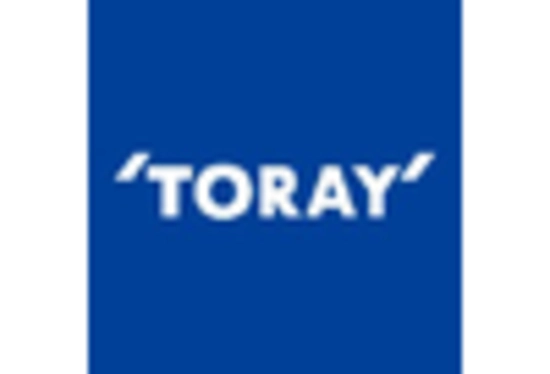The Thermoplastic Composites Market is currently characterized by a dynamic competitive landscape, driven by increasing demand for lightweight materials across various industries, including automotive, aerospace, and consumer goods. Key players such as Toray Industries (Japan), BASF SE (Germany), and SABIC (Saudi Arabia) are strategically positioned to leverage their technological advancements and extensive product portfolios. Toray Industries (Japan) focuses on innovation in carbon fiber reinforced thermoplastics, aiming to enhance performance and reduce weight in automotive applications. Meanwhile, BASF SE (Germany) emphasizes sustainability, developing eco-friendly thermoplastic composites that align with global environmental standards. SABIC (Saudi Arabia) is actively pursuing regional expansion, particularly in Asia, to capitalize on the growing demand for advanced materials in emerging markets. Collectively, these strategies contribute to a competitive environment that is increasingly focused on innovation and sustainability.
In terms of business tactics, companies are localizing manufacturing to reduce lead times and optimize supply chains. The market structure appears moderately fragmented, with several players vying for market share while also collaborating on joint ventures and partnerships. This collective influence of key players fosters a competitive atmosphere where agility and responsiveness to market demands are paramount.
In August 2025, Toray Industries (Japan) announced the launch of a new line of thermoplastic composites specifically designed for electric vehicle applications. This strategic move is significant as it positions Toray to meet the rising demand for lightweight, high-performance materials in the rapidly growing electric vehicle sector, potentially enhancing their market share and reinforcing their reputation as a leader in innovation.
In September 2025, BASF SE (Germany) unveiled a partnership with a leading automotive manufacturer to develop sustainable thermoplastic composites. This collaboration underscores BASF's commitment to sustainability and innovation, as it aims to create materials that not only meet performance standards but also reduce environmental impact, thereby appealing to eco-conscious consumers and manufacturers alike.
In October 2025, SABIC (Saudi Arabia) expanded its production capabilities in Asia by investing in a new facility dedicated to thermoplastic composites. This expansion is likely to enhance SABIC's ability to serve the growing demand in the region, positioning the company favorably against competitors and allowing for more efficient supply chain management.
As of October 2025, current competitive trends in the Thermoplastic Composites Market are increasingly defined by digitalization, sustainability, and the integration of artificial intelligence in manufacturing processes. Strategic alliances are becoming more prevalent, as companies recognize the value of collaboration in driving innovation and enhancing product offerings. Looking ahead, competitive differentiation is expected to evolve, shifting from traditional price-based competition to a focus on technological advancements, sustainable practices, and supply chain reliability. This transition may redefine market dynamics, compelling companies to innovate continuously to maintain their competitive edge.


















Leave a Comment